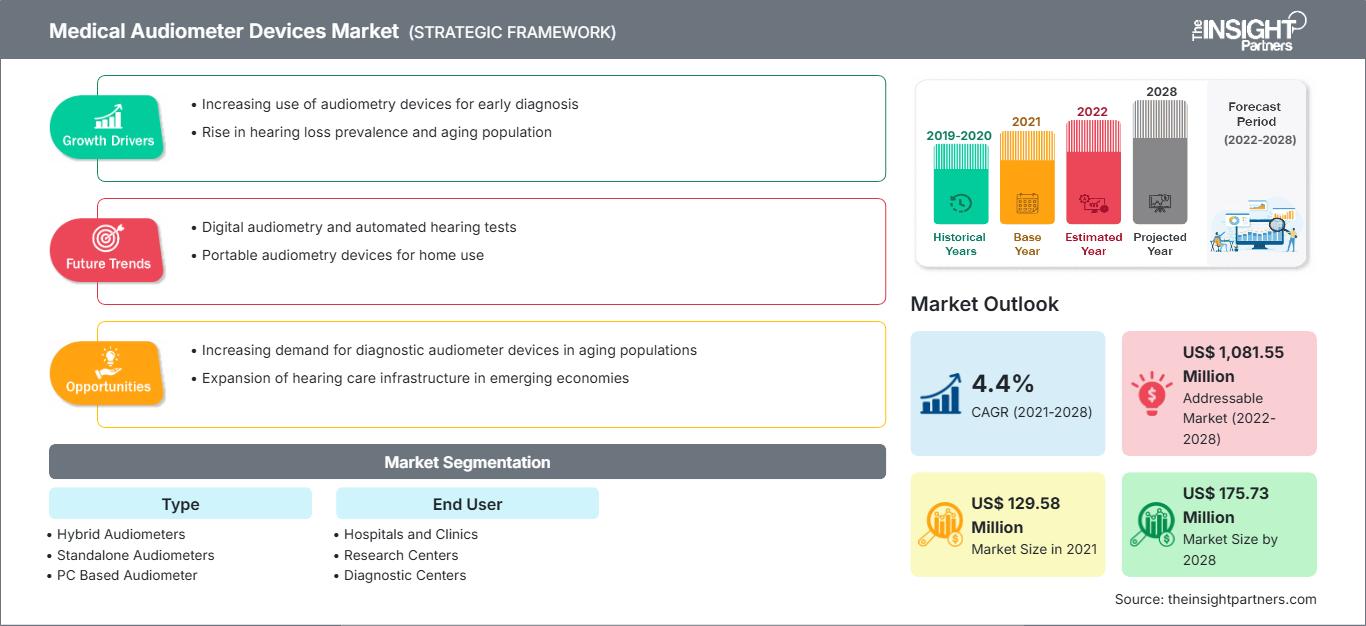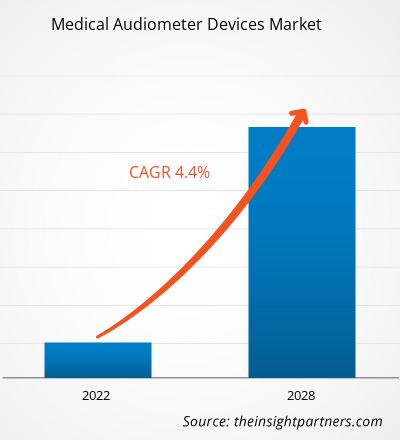Si prevede che il mercato degli audiometri medici raggiungerà i 175,73 milioni di dollari entro il 2028, rispetto ai 129,58 milioni di dollari del 2021; si prevede una crescita a un CAGR del 4,4% dal 2021 al 2028.
Gli audiometri medici sono dispositivi utilizzati per valutare il livello di udito e misurare e diagnosticare la gravità della perdita uditiva. Gli audiometri sono costituiti da hardware integrato e da un pulsante di feedback per il partecipante al test, collegato a un paio di cuffie. Per controllare questo sistema viene utilizzato un normale PC. L'audiometria è una tecnica per determinare la capacità uditiva di una persona. I tipi di procedure audiometriche includono l'audiometria a impedenzometria, l'audiometria tonale pura, l'audiometria a risposta evocata e l'audiometria vocale. Diversi progressi tecnologici hanno portato allo sviluppo di audiometri ibridi e audiometri basati su PC per comunicare e migliorare la qualità della vita.
Il mercato degli audiometri medici è stato segmentato in base a tipologia, utente finale e area geografica. Per area geografica, il mercato è principalmente segmentato in Nord America, Europa, Asia-Pacifico, Medio Oriente e Africa e America Meridionale e Centrale. Il rapporto offre approfondimenti e analisi approfondite del mercato degli audiometri medicali, evidenziando le tendenze di mercato, i progressi tecnologici, le dinamiche di mercato e l'analisi del panorama competitivo dei principali attori del mercato a livello globale.
Personalizza questo rapporto in base alle tue esigenze
Potrai personalizzare gratuitamente qualsiasi rapporto, comprese parti di questo rapporto, o analisi a livello di paese, pacchetto dati Excel, oltre a usufruire di grandi offerte e sconti per start-up e università
Mercato dei dispositivi audiometrici medici: Approfondimenti strategici

-
Ottieni le principali tendenze chiave del mercato di questo rapporto.Questo campione GRATUITO includerà l'analisi dei dati, che vanno dalle tendenze di mercato alle stime e alle previsioni.
Approfondimenti di mercato
Crescente prevalenza di disturbi dell'udito
La prevalenza di disturbi dell'udito è in aumento in tutto il mondo. I disturbi dell'udito possono portare a una riduzione dell'udito superiore a 40 decibel (dB) nell'orecchio più uditivo negli adulti e superiore a 30 dB nell'orecchio più uditivo nei bambini. I disturbi dell'udito possono essere una disabilità ereditaria o congenita, oppure possono essere causati da malattie infettive, infezioni croniche dell'orecchio, esposizione a rumori eccessivi e vecchiaia. Anche infezioni infantili come morbillo, parotite e meningite, esposizione a rumori eccessivi o prolungati e otite media cronica sono responsabili della perdita dell'udito. La perdita dell'udito è diventata la malattia più comune nei pazienti, soprattutto nei paesi industrializzati. Secondo l'Organizzazione Mondiale della Sanità (OMS), circa il 5% della popolazione mondiale soffre di problemi di udito. Si prevede che il numero di persone affette da questa patologia supererà i 900 milioni entro il 2050. Analogamente, secondo la Hearing Industries Association, nel 2019 negli Stati Uniti sono stati distribuiti oltre 4,22 milioni di apparecchi acustici, con un aumento del 6,5% rispetto al numero riportato nel 2018.
Secondo il rapporto della Hearing Loss Association of America (HLAA), Hearing Loss Facts and Statistics 2018, circa 48 milioni di americani soffrono di un certo grado di ipoacusia. Si afferma inoltre che da 2 a 3 bambini su 1.000 negli Stati Uniti nascono con un livello rilevabile di ipoacusia in una o entrambe le orecchie. Secondo i dati riportati dai Centers for Disease Control and Prevention, circa il 16% degli adulti negli Stati Uniti riferisce di avere problemi di udito e 1 uomo su 5 e 1 donna su 8 hanno riferito di avere qualche tipo di problema di udito. La prevalenza della perdita dell'udito è due volte più comune del diabete o del cancro. Circa l'11% degli americani riferisce acufene o ronzio nelle orecchie.
Pertanto, la crescente prevalenza di disturbi dell'udito e perdita dell'udito tra la popolazione sta incrementando le vendite di audiometri medici.
Approfondimenti basati sulla tipologia
In base alla tipologia, il mercato degli audiometri medici è segmentato in audiometri ibridi, audiometri autonomi e audiometri basati su PC. Il segmento degli audiometri basati su PC rappresenterà la quota di mercato maggiore nel 2021 e si prevede che il segmento degli audiometri ibridi registrerà il CAGR più elevato durante il periodo di previsione.
Approfondimenti basati sull'utente finale
In base all'utente finale, il mercato degli audiometri medici è segmentato in ospedali e cliniche, centri di ricerca e centri diagnostici. Il segmento ospedali e cliniche deterrà la quota maggiore del mercato nel 2021 e si stima che lo stesso segmento registrerà il CAGR più elevato del mercato durante il periodo di previsione.
La pandemia di COVID-19 è diventata la sfida più significativa a livello mondiale. Poiché questa pandemia ha messo a dura prova i sistemi sanitari di tutto il mondo, dare priorità alle risorse limitate è stato essenziale per ridurre al minimo i ricoveri ospedalieri. Tuttavia, gli operatori del mercato hanno adottato un approccio innovativo di soluzioni di tele-audiologia per gestire i pazienti con ipoacusia. Ad esempio, Satellite Tele-Audiology Solutions, parte dell'azienda Inventis, è considerata la prima tecnologia del suo genere. Questa tecnologia consente agli audiologi di interagire ed eseguire da remoto valutazioni uditive complete con i loro pazienti in tempo reale. Tali sviluppi da parte dei principali operatori del mercato hanno ridotto al minimo l'impatto della pandemia di COVID-19 sul mercato dei dispositivi audiometrici medicali.
Acquisizioni, collaborazioni, partnership, lanci di prodotti ed espansioni sono strategie comunemente adottate dalle aziende per espandere la propria presenza a livello mondiale e soddisfare la crescente domanda. Gli operatori del mercato dei dispositivi audiometrici medici hanno adottato principalmente la strategia dell'innovazione di prodotto per soddisfare la mutevole domanda dei clienti in tutto il mondo, il che li aiuta anche a mantenere il loro marchio a livello globale.
Approfondimenti regionali sul mercato dei dispositivi audiometrici medici
Le tendenze regionali e i fattori che influenzano il mercato dei dispositivi audiometrici medicali durante il periodo di previsione sono stati ampiamente spiegati dagli analisti di The Insight Partners. Questa sezione illustra anche i segmenti e la geografia del mercato dei dispositivi audiometrici medicali in Nord America, Europa, Asia-Pacifico, Medio Oriente e Africa, America meridionale e centrale.
Ambito del rapporto di mercato sui dispositivi audiometrici medici
| Attributo del rapporto | Dettagli |
|---|---|
| Dimensioni del mercato in 2021 | US$ 129.58 Million |
| Dimensioni del mercato per 2028 | US$ 175.73 Million |
| CAGR globale (2021 - 2028) | 4.4% |
| Dati storici | 2019-2020 |
| Periodo di previsione | 2022-2028 |
| Segmenti coperti |
By Tipo
|
| Regioni e paesi coperti |
Nord America
|
| Leader di mercato e profili aziendali chiave |
|
Densità degli operatori del mercato dei dispositivi audiometrici medici: comprendere il suo impatto sulle dinamiche aziendali
Il mercato degli audiometri medicali è in rapida crescita, trainato dalla crescente domanda degli utenti finali, dovuta a fattori quali l'evoluzione delle preferenze dei consumatori, i progressi tecnologici e una maggiore consapevolezza dei vantaggi del prodotto. Con l'aumento della domanda, le aziende stanno ampliando la propria offerta, innovando per soddisfare le esigenze dei consumatori e sfruttando le tendenze emergenti, alimentando ulteriormente la crescita del mercato.

- Ottieni il Mercato dei dispositivi audiometrici medici Panoramica dei principali attori chiave
Profili aziendali
- Benson Medical Instruments Co.
- Hedera Biomedics Srl
- Smart Diagnostic Devices
- Natus Medical Incorporated
- INVENTIS SRL
- Auditdata
- MedRx
- INTERACOUSTICS AS
- RESONANCE
- Hill Rom Holding Inc.
- Analisi storica (2 anni), anno base, previsione (7 anni) con CAGR
- Analisi PEST e SWOT
- Valore/volume delle dimensioni del mercato - Globale, Regionale, Nazionale
- Industria e panorama competitivo
- Set di dati Excel
Report recenti
Rapporti correlati
Testimonianze
Motivo dell'acquisto
- Processo decisionale informato
- Comprensione delle dinamiche di mercato
- Analisi competitiva
- Analisi dei clienti
- Previsioni di mercato
- Mitigazione del rischio
- Pianificazione strategica
- Giustificazione degli investimenti
- Identificazione dei mercati emergenti
- Miglioramento delle strategie di marketing
- Aumento dell'efficienza operativa
- Allineamento alle tendenze normative






















 Ottieni un campione gratuito per - Mercato dei dispositivi audiometrici medici
Ottieni un campione gratuito per - Mercato dei dispositivi audiometrici medici